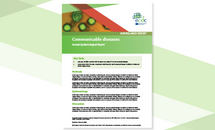Antimicrobial resistance in the EU/EEA (EARS-Net) - Annual epidemiological report for 2021
Twenty-nine European Union/European Economic Area (EU/EEA) countries reported cases of pathogens with antimicrobial resistance (AMR) to the European Antimicrobial Resistance Surveillance Network (EARS-Net) for 2021, based on data for invasive bacterial isolates (i.e. retrieved from blood or cerebrospinal fluid). Twenty- eight countries reported cases for all eight bacterial species under surveillance by EARS-Net (Escherichia coli, Klebsiella pneumoniae, Pseudomonas aeruginosa, Acinetobacter species, Streptococcus pneumoniae, Staphylococcus aureus, Enterococcus faecalis and Enterococcus faecium), while one country (Greece) reported data for all bacterial species except S. pneumoniae.
Executive summary
Key facts
- During 2020 and 2021, reporting of cases of pathogens with antimicrobial resistance (AMR) coincided with changes in healthcare and the community resulting from the global COVID-19 pandemic, which will have affected infection prevention and control activities targeting these pathogens.
- Overall in 2021, the most commonly reported bacterial species was E. coli (39.4% of all reported cases), followed by S. aureus (22.1%), K. pneumoniae (11.9%), E. faecalis (8.8%), E. faecium (6.2%), P. aeruginosa (6.1%), Acinetobacter spp. (3.0%) and S. pneumoniae (2.5%). This ranking is different to 2020, since E. faecium and Acinetobacter spp. are one rank higher.
- Between 2020 and 2021, the number of reported cases increased for all pathogens. The largest increases were observed for Acinetobacter spp. (+43%), E. faecium (+21%) and E. faecalis (+14%), with smaller increases for S. aureus (+9.4%), P. aeruginosa (+8.2%), K. pneumoniae (+8.1%), S. pneumoniae (+4.3%), and also for the most frequently reported pathogen - i.e. E. coli (+2.8%).
- In 2021, the most striking observation was the overall increase in the number of reported cases of Acinetobacter spp. which mostly belong to the A. baumannii complex in the EU/EEA. This does not appear to be a feature of improved reporting, as the increase was confirmed among the laboratories that consistently reported data each year during the period 2017–2021 (n=666). On average, there was more than double (+121%) the number of reported cases resistant to each of the three antimicrobial groups (carbapenems, fluoroquinolones and aminoglycosides) in 2021 than the average for 2018−2019. In addition, the population- weighted mean AMR percentage had increased by more than 20% for each of these groups.
- The greatest increases in the number of cases and AMR percentages of Acinetobacter spp. were reported by countries that already had high AMR percentages in their reported Acinetobacter spp. cases prior to 2020. At country level, among all reporting laboratories in 2021, the percentage of Acinetobacter spp. cases resistant to all three antimicrobial groups ranged from 0.0–98.5%.
- Together, these findings imply that the situation with Acinetobacter spp. in the EU/EEA has deteriorated for the second year in a row. Acinetobacter spp. in healthcare is problematic since it can persist in the healthcare environment for long periods and is notoriously difficult to eradicate once established. AMR reduces options for treatment of infections. Options for national preparedness and response include ensuring that hospitals can perform timely screening, laboratory reporting and pre-emptive isolation of high-risk patients; good infection prevention and control; rigorous environmental cleaning and disinfection and antimicrobial stewardship programmes.
- For K. pneumoniae, the percentage of cases resistant to carbapenems continued to increase, and this was also observed among laboratories that continuously reported data from 2017 to 2021. In these laboratories, the percentage remained unchanged from 2017 to 2018, and increased by +8% from 2018 to 2019. Then, in 2020, the percentage of carbapenem-resistant K. pneumoniae cases reported by these laboratories increased by a further +31%, and in 2021 by another +20%. The percentages of carbapenem-resistant cases varied widely by country (0–73.7%), implying that there are still further opportunities to counter this AMR threat.
- As in 2020, for E. faecium, the increase in the number and percentage of cases with vancomycin resistance continued in 2021, although the relative importance of this finding for public health in the EU/EEA is currently unclear, compared to the trends in other pathogens noted above.
- For S. pneumoniae, there had been a large decrease in the number of reported cases in the EU/EEA in 2020 compared to 2019. However, this number remained relatively stable in 2021. In this context, the percentage of penicillin non-wild-type cases increased from 14% in 2017 to 16% in 2021.
- Otherwise, during 2017−2021, for the EU/EEA (excluding the United Kingdom), most of the bacterial species–antimicrobial combinations under surveillance showed either a significantly decreasing trend or no significant trend in the population-weighted mean AMR percentage, in particular E. coli (other than carbapenem-resistant), K. pneumoniae (other than carbapenem-resistant), P. aeruginosa and meticillin- resistant S. aureus (MRSA). Nevertheless, these pathogens remain important in the EU/EEA, with high AMR percentages. For example, more than half (53.1%) of all reported E. coli cases in 2021 were resistant to at least one antimicrobial group under surveillance, compared to about a third (34.3%) of K. pneumoniae cases and about a fifth (18.7%) of P. aeruginosa cases. However, as expected, AMR percentages were generally higher for K. pneumoniae and P. aeruginosa than for E. coli for each reported antimicrobial group/agent.
- The reported AMR percentages varied widely among countries for several bacterial species– antimicrobial group combinations, often with a north-to-south and west-to-east gradient. In general, the lowest AMR percentages were reported by countries in the north of the EU/EEA, and the highest by countries in the south and east of the EU/EEA.
- The latest country-specific data can be retrieved from the ECDC Surveillance Atlas of Infectious Diseases.
- In 2021, 22 (76%) participating countries classified the national representativeness of their reported EARS-Net data as ‘high’ for all three recorded standard metrics of national representativeness. These metrics are the geographical areas covered, the included acute care hospitals, and the microorganisms that caused invasive infections in participating hospitals. In the 22 countries, the rate at which blood cultures were obtained from patients was three-fold higher than in the four countries that reported one or none of the metrics of national representativeness as ‘high’. Appropriate microbiological testing of blood samples is a pre-requisite for adjusting the appropriateness of antimicrobial prescriptions to treat infections, and for reducing AMR.
Download






